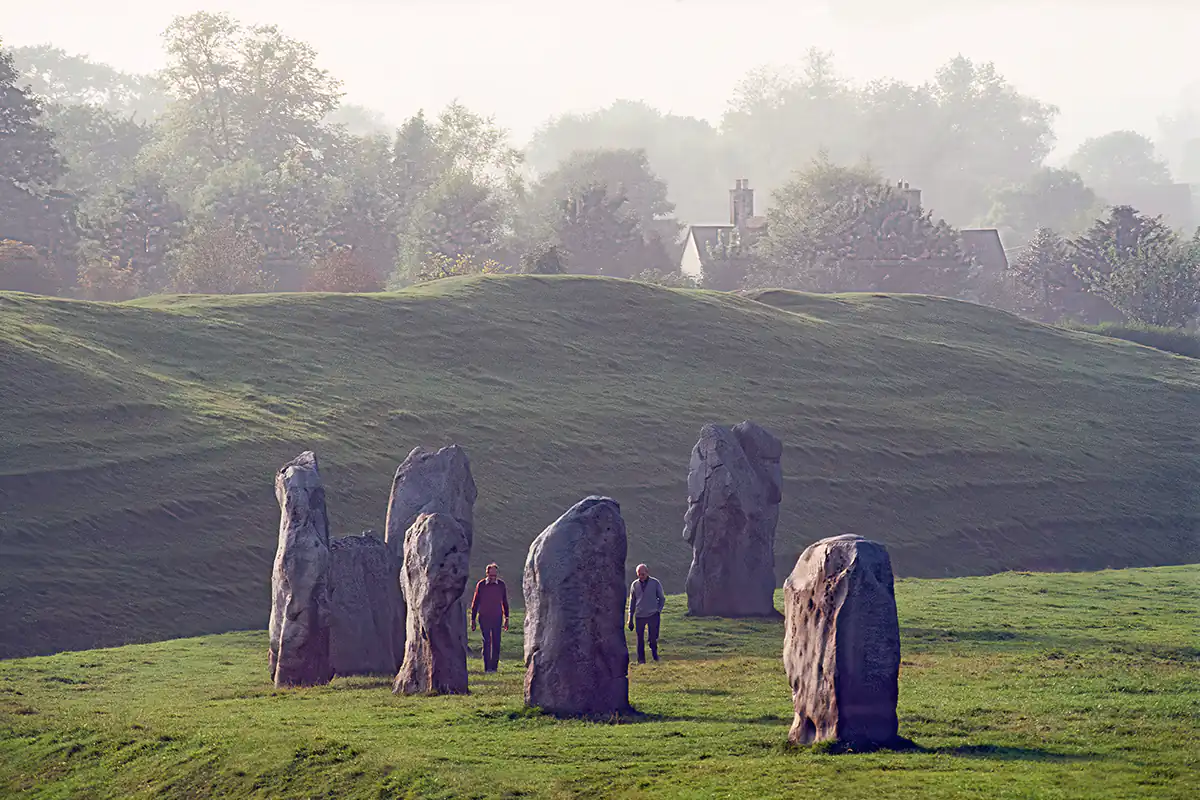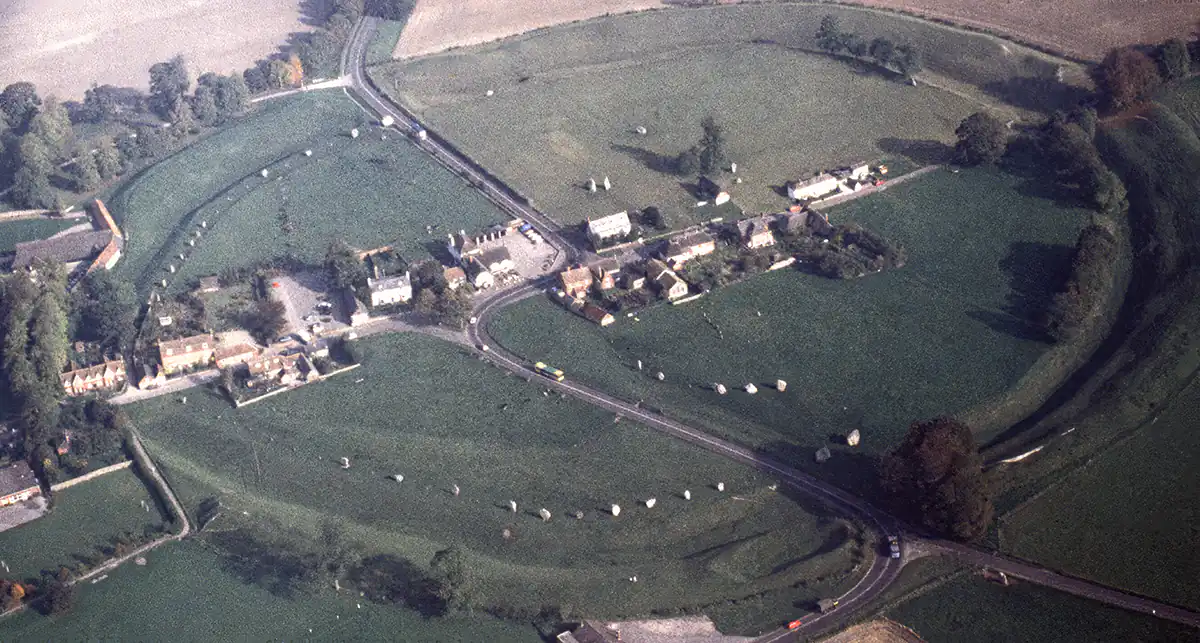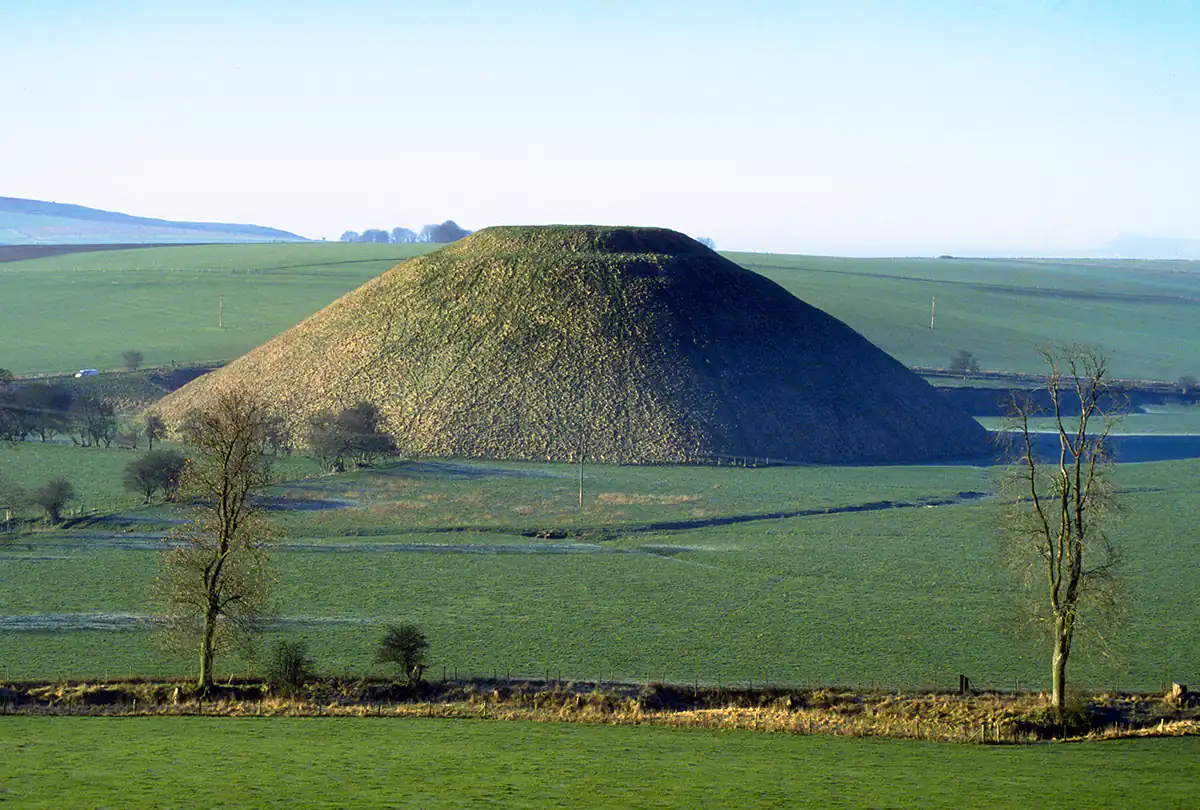Avebury
Ninety miles west of London and twenty miles north of Stonehenge stands Avebury, the largest known stone ring in the world. Older than the more famous Stonehenge, and for many visitors far more spectacular, the multiple rings of Avebury are cloaked with mysteries that archaeologists have only begun to unravel.
Similar to Stonehenge and many other megalithic monuments in the British Isles, Avebury is a composite construction that was added to and altered during several periods. As the site currently exists, the great circle consists of a grass-covered, chalk-stone bank that is 1,396 feet in diameter (427 meters) and 20 feet high (6 meters) with a deep inner ditch having four entrances at the cardinal compass points. Just inside the ditch, which was not used for defensive purposes, lies a grand circle of massive and irregular sarsen stones enclosing approximately 28 acres of land. This circle, originally composed of at least 98 stones but now having only 27, encloses two smaller stone circles. The two inner circles were probably constructed first, around 2600 BC, while the large outer ring and earthwork dates from 2500 BC. The northern circle is 320 feet in diameter and originally had twenty-seven stones, of which only four remain standing today; the southern circle is 340 feet across and once contained twenty-nine stones, of which only five remain standing.
The construction of the Avebury complex must have required enormous efforts from the local inhabitants. The sarsen stones, ranging in height from nine to over twenty feet and weighing as much as 40 tons, were first hewn from bedrock and then dragged or sledded nearly two miles from their quarry site. These stones were then erected and anchored in the ground to depths between 6 and 24 inches. The excavation of the encircling ditch required an estimated 200,000 tons of rock to be chipped and scraped away with the crudest of stone tools and antler picks. There is evidence that this ditch was once filled with water, thereby giving the inner stone rings the appearance of being set upon an island.
From excavation and soil resistivity studies, it is known that the three rings originally contained at least 154 stones, of which only 36 remain standing today. There are three reasons for the disappearance of these stones. In the 14th century, and perhaps earlier, the local Christian authorities, in their continuing effort to eradicate any vestiges of pagan religious practices, toppled, broke up, and buried many stones. Later, in the 17th and 18th centuries, still more of the remaining stones were removed from their foundations. Crops could then be planted in these areas, and the massive stones could be broken into smaller pieces to construct houses and other buildings.
In the early years of the 18th century, however, the general outline of the Avebury temple was still visible. Dr. William Stukeley, an antiquarian who frequently visited the site in the 1720s, watched in dismay as the local farmers, unaware of the cultural and archaeological value of the ancient temple, continued with its destruction. For over thirty years, Stukeley made careful measurements and numerous drawings of the site, our only record of the ancient temple's immense size and complexity today.
Stukeley was the first observer in historical times to recognize that the original ground plan of Avebury represented the body of a serpent passing through a circle, thus forming a traditional alchemical symbol. 50-foot wide avenues of standing stones delineated the head and tail of the enormous snake, each extending 1 and 1/2 miles into the countryside. One of the avenues terminated at another stone ring known as the 'sanctuary.' Continuing his explorations and mapping the countryside surrounding the stone serpent, Stukeley gathered evidence that the sacred complex of Avebury included many other massive earth and stone monuments.
Only 1500 meters south of the main Avebury rings stands Silbury Hill, the largest, and perhaps the most enigmatic, of all European megalithic constructions. Crisscrossing the surrounding countryside are numerous meandering lines of standing stones and mysterious underground chambers, many positioned according to astronomical alignments. Perhaps the most astonishing revelations of Avebury's ancient grandeur have come through the recent research of John Michell, Paul Broadhurst, and Hamish Miller. Drawing upon legends and folklore, archaeological excavations, and dowsing, these specialists have determined that the Avebury temple was part of a vast network of neolithic sacred sites arranged along a nearly two-hundred-mile line stretching across southern England. The great pilgrimage sites of Glastonbury Tor and St.Michael's Mount are positioned directly on this line. For additional information on this line and its sites, consult Hamish Miller's book, The Sun and the Serpent.
The length of time for the main continuity of use of the Avebury complex throughout the Neolithic and Early Bronze Age was, according to present dating studies, around 2300 years. This lengthy period and the vast size of the whole complex give testimony to the fact that the Avebury temple was perhaps the most significant sacred site in all of Britain, if not the entire continent of Europe. And what of its use? Various conjectures have been made, but it is premature to speak with any certainty. Fathoming the mysteries of Avebury will still take some years. Only since the 1980s has the essential meeting of science and spirit, archaeology, and intuition occurred that may unlock the secrets of this wondrous place. An excellent book discussing the site is Avebury Cosmos by Nicholas Mann.
For additional information:

Martin Gray is a cultural anthropologist, writer and photographer specializing in the study of pilgrimage traditions and sacred sites around the world. During a 40 year period he has visited more than 2000 pilgrimage places in 160 countries. The World Pilgrimage Guide at sacredsites.com is the most comprehensive source of information on this subject.



